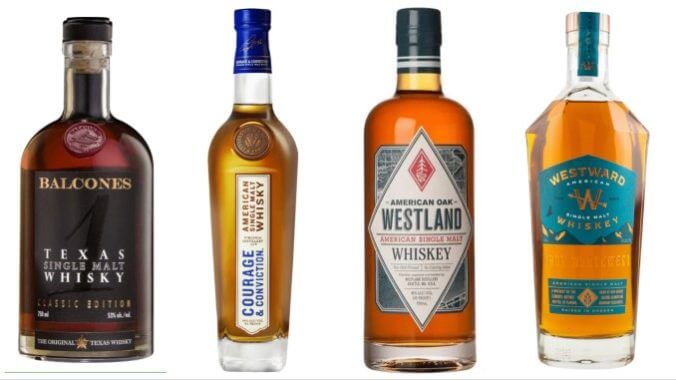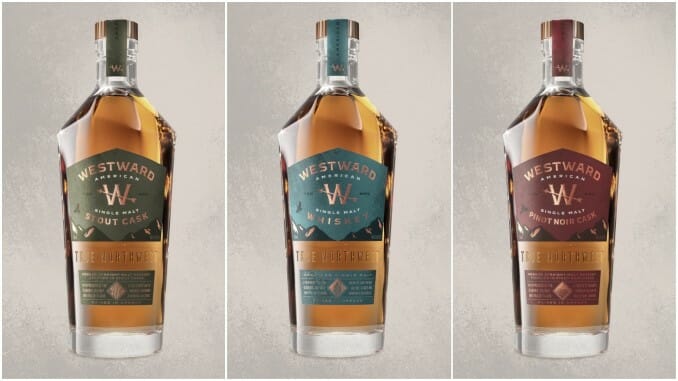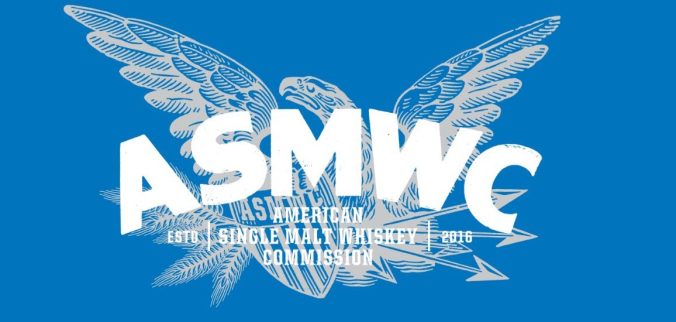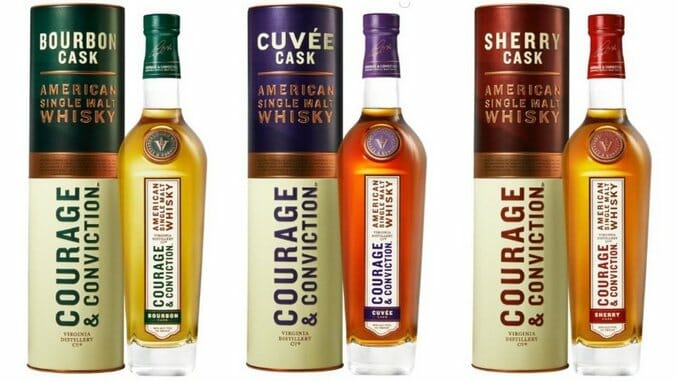A Whiskey Style Comes of Age: American Single Malt Is All Grown Up
Photos via American Single Malt Whiskey Commission
In the near future, the Tax and Trade Bureau (TTB), which oversees the labeling and sale of alcoholic spirits in the U.S., is expected to officially announce the formal definition and category for a style of whiskey that had simply existed in the market as a collective idea for the last few decades: American single malt. In doing so, it will be the largest new category of spirit that the regulatory body has officially defined in decades, an arguably overdue move that will officially canonize a category that has been steadily growing in both complexity and popularity in the U.S. for the last 20 years or more. American single malt whiskey is hardly a new concept at this point, though it still may be a mystery to many everyday consumers of better known American whiskey styles such as bourbon and rye. But its official recognition symbolizes a major rite of passage, presaging a new era where American single malt whiskeys should be more visible in the market than ever. Most distilleries making this style of whiskey seem to be welcoming the news, even as a few raise concerns about the way any definition might stymie creativity and free expression in probing the experimental side of whiskey making.
The truth of the category, though, is that the new definition for American single malt whiskey reflects the undeniable fact that this has already become a very broad and diverse style, one that is so open-ended that two different distilleries can produce single malt whiskeys that hardly bear any resemblance to each other at all. This is a product of the innovation that has already occurred in the last few decades, as distilleries in various parts of the country tackled the task of making malt whiskey radically differently. Bringing all of these companies together under the banner of “American single malt” required a definition that tightly controlled some aspects of production while allowing for vast levels of freedom and choice in others.
So with that said, let’s dive into the important details of the definition, and then examine how several major producers of American single malt whiskey differ in how they choose to produce it.
American Single Malt Whiskey, Defined
First of all, we should define what differentiates these whiskeys from the other malt whiskeys we most often encounter in the U.S., which for almost all of us would be scotch whisky from Scotland. The phrase “scotch whisky” can refer to any number of things, including single malt whiskies, single grain whiskies and blends of the two, or blends of many malts from various distilleries. The word “single,” then, refers simply to how many distilleries were involved: A “single malt” whiskey implies that the product was 100% produced from malted barley rather than any other grain, and is the sole product of a single distillery. All the same applies to American single malt whiskeys, which must meet the following standards:
— Distilled from 100% malted barley
— Product of one distillery
— Mashed, distilled and matured in the United States
— Matured in oak casks no larger than 700 liters
— Distilled to no more than 160 proof (distillation proof)
— Bottled at a strength of at least 40% ABV (80 proof)
There are several notable, important differences here between the laws governing American single malt whiskey and Scottish single malts. One is the maximum distillation proof of 160, a level perhaps chosen to match that of bourbon, where 160 is also the legal maximum. This is important because lower distillation proofs actually result in a more flavorful (but less technically efficient) spirit, as more complex flavors are stripped away the closer one gets to pure ethanol, or 200 proof. In the scotch industry, the legal maximum is all the way up to 190 proof (not that this is commonly employed for malts), but setting the maximum to 160 proof in the U.S. would prevent any distillery from making what is effectively grain neutral spirit and still being able to technically label it American single malt whiskey.

The line about casks/barrels is also of importance, establishing a maximum size (the largest common European wine casks) but not a minimum, which gives distilleries the green light to use barrels smaller than the standard 53 gallon “beer barrel” that consumers are most familiar with, if they wish. These smaller barrels are sometimes used to speed maturation by increasing oak surface contact with the liquid, but they may also be used for experimental or minor component blending purposes.
Likewise, one will note that there’s no mention at all of needing to use new oak, charred or uncharred, in the above definition, as there is in bourbon. This was to be expected, as American single malts produced over the last two decades have run the gamut from those aged in reused American whiskey casks (in the Scottish tradition), to malt whiskeys aged in newly charred oak, to any and all other styles of spirit and wine casks. The definition therefore allows distilleries to use any kind of cask they want, as long as it’s oak. Notably, some American single malt producers object to this final point, wanting to be able to use woods beyond various species of oak, but this is a fairly marginal concern.
Finally, there is no minimum age statement required for a distillery to be able to label its product as American single malt whiskey, which theoretically befits a younger segment of the market where there are many youthful whiskeys. On the negative side, you could perhaps say that the consumer has relatively little assurance that the whiskey they’re buying has been aged for a significant amount of time, which leaves the responsibility up to each distillery to explain their own process.
How Different Distilleries Tackle American Single Malt
The push to codify American single malt whiskey as a category was led over the years by the ASMWC, the American Single Malt Whiskey Commission. This is an organization whose member distilleries–almost 100 of them now, though there are reportedly more than 200 making malt whiskey in the U.S.–are extremely diverse, being located all over the 50 states, while employing radically different techniques to distill and age whiskey. But all of the dozens of members of the ASMWC lined up behind the effort to lobby the TTB for the official designation, feeling that it would bolster the style’s visibility, viability and commercial prospects in the United States.

“The formalization of the American Single Malt category by the TTB is a historic moment for the industry, as it has been decades since a new whisky category of this magnitude has been added to the Beverage Alcohol Manual,” said CEO Gareth Moore of the Charlottesville area Virginia Distillery Co., which specializes in malt whiskey. “The American whisky category was synonymous with bourbon just 15 years ago, but the resurgence of rye diversified that view. The American Single Malt category will further broaden the view of the American whisky consumer and fuel innovation and premiumization across domestic products. Once the category is defined, we feel that there will still be many areas left open for creativity. Our hope is that these definitions will be viewed as a protective foundation to build upon. We’re simply looking to maintain a basic standard that will provide clarity and consistency not only for the producers, but also for the consumers who enjoy single malt whiskies.”
Moore’s distillery, often abbreviated as VDC, was built from the start to be one of the country’s biggest American single malt producers, though they stand out conceptually for how rooted the company’s style is in the Scottish tradition. Largely eschewing newly charred oak outside of some small-scale experimentation, Virginia Distillery Co. offers rich, fruity, non-peated single malt whiskeys aged in three primary styles of cask: Ex-bourbon, ex-sherry and ex-red wine casks that have been shaved, toasted and re-charred (“STR” casks in industry terms), which the company refers to as cuvee casks. All three styles are available individually, but the flagship product of the distillery, Courage & Conviction, is actually a blend of all three. This kind of focus on blending is a common element of the scotch whisky industry, but not necessarily so among American single malt producers, who may focus in more tightly on only one or two brands rather than numerous spirits they intend to blend.

Indeed, to many drinkers one of the defining aspects of American single malt is actually the use of newly charred oak as the element that makes these whiskeys truly “American” rather than U.S.-based versions of Scottish malt whisky. For brands such as Portland, Oregon’s Westward Whiskey or Denver’s Stranahan’s, newly charred oak is an essential facet of a malt whiskey that takes more than a little inspiration from the craft beer world, utilizing an array of brewer’s malts rather than the more neutral malt typically used by traditional distillers. As one would expect, the use of new oak notably accelerates the aging process and acquisition of color for the spirit, resulting in a profile that is more radically transformed by the char, sweetness and chemical compounds (such as vanillans) found in layers of charred and toasted wood. Even if a company like Westward or Stranahan’s was to ferment and distill a similar mash bill to what VDC is doing, the difference in casks alone would result in an unrecognizably different product. And this is still really just the tip of the iceberg, as a pioneering brand such as McCarthy’s Oregon Single Malt Whiskey from Hood River Distillers is likewise totally different from the previous two examples thanks to its heavy use of smoky, peated malt, which results in single malts that bear more in common with the fiery, smoky malt whiskies of Islay in Scotland. If you put samples of all these brands in front of a blind-tasting panel of average consumers, they likely would never even guess that all the products were malt whiskey.
The takeaway, at the end of the day, is that there’s likely still a whole lot of runway ahead of American single malt whiskey as a category, with a majority of American spirits consumers having never even encountered or sampled one at this point. Even among longtime scotch whisky drinkers, I expect there’s still probably a large contingent who haven’t made time to explore malt whiskeys made in the U.S.A., but that status quo seems ripe for a change. Within a few years, who can say how much this category might be able to grow? Perhaps the growing bourbon fatigue will be exactly what many of these companies need to build a new core consumer base.
“There is such a rich and exciting world of American single malts,” said Moore in our interview. “If someone wants to truly experience the sense of place that a pour of whisky can showcase, American single malts are the ideal spirit to drink. From the beauty of the barley itself, to a wealth of creativity in aging and finishing programs, there’s so much to be discovered and enjoyed in the ASM world. So many people have fallen in love with American single malts, and we believe the best is yet to come.”
Jim Vorel is a Paste staff writer and resident beer and liquor geek. You can follow him on Twitter for more drink writing.







































